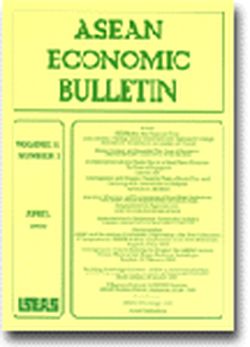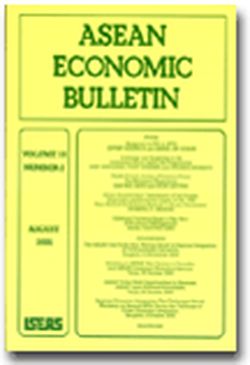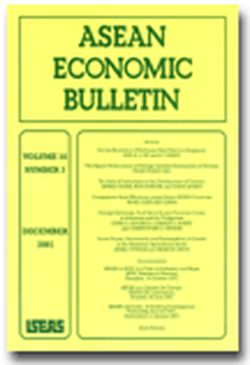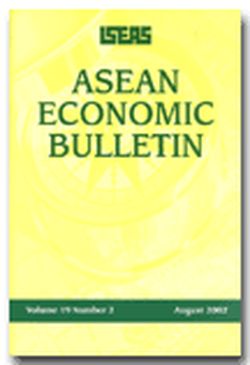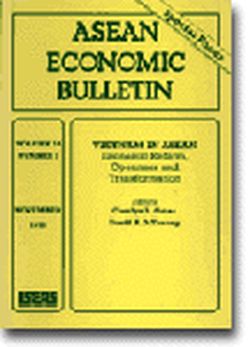ASEAN Economic Bulletin Vol. 16/2 (Aug 1999)
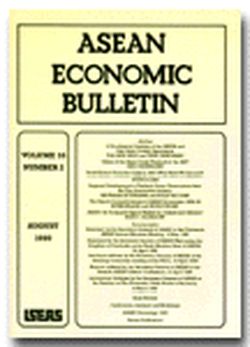
Date of publication:
August 1999
Number of pages:
136
Code:
AE16/2
Contents
-
Preliminary pages
-
A Neoclassical Analysis of the ASEAN and East Asian Growth Experience, by Toh Mun Heng, Tiew Chee Siang, authors see abstractThis study examines the growth experience of the ASEAN and East Asian countries from a neoclassical perspective. Using data from 196094 for Indonesia, Malaysia, the Philippines, Thailand, Hong Kong, South Korea, Singapore, Taiwan and Japan, the neoclassical proposition of conditional convergence was evaluated. The speed of convergence of ASEAN and East Asian countries to their respective steady state levels of per capita GDP, conditional on the initial endowment of the physical and human capital, is estimated at 4.8 per cent per year. This result indicates that, were the poor countries of the ASEAN community to attain levels of physical and human capital investment, rates of savings, productivity growth, and population growth similar to those of the rich countries, per capita incomes in the former would grow significantly faster than those in the latter.
-
Villain of the Asian Crisis: Thailand or the IMF?, by Anis Chowdhury , author see abstractThis article traces the roots of the Asian financial crisis in the weakness of the Thai economy. By using an accounting framework, the author demonstrates that the IMF/World Bank structural adjustment programme in the 1980s failed to achieve resource switching from the non-tradable to tradable sector, as successive devaluations had to be matched with upward adjustment of minimum wages due to political reality. The improvement in the fiscal position was achieved primarily by a politically easier route of cutting infrastructure investment with detrimental effects on long-term growth. Thus, the seed of the crisis was sown in the straight-jacket IMF/World Bank programmes of the 1980s.
-
South Korea's Financial Crisis in 1997: What Have We Learned?, by Byung S. Min, author see abstractThe South Korean "big bang in 1997" was triggered by both endogenous factors such as moral hazard effects and suboptimal foreign debt management, and negatively affected exogenous factors such as contagion effects of the Asian crisis, co-ordination failure effects and terms of trade shocks. An analysis of the South Korean episode implies that: (1) both sustainability and liquidity ought to be considered for an optimal foreign debt policy, particularly during the liberalization of capital markets; (2) a proper corporate governance, coupled with transparency and increased foreign competition, are important to increase the efficiency of big conglomerates; (3) a mechanism for effective global co-ordination is required to cope with the contagion effect, and to promote integration of developing economies into the world market.
-
Regional Development in Thailand: Some Observations from the Thai Automotive Industry, by Philip McCann, Sauwalak Kittiprapas, authors see abstractThe article investigates the location behaviour of firms in the automotive industries in Thailand. Our approach is to use a logit model in order to analyse how the characteristics of the firms and the regions are related to the location decisions of firms in these sectors. The logit results throw some light on the question of the nature of agglomeration behaviour in a developing economy where the national spatial industrial structure is dominated by a single primal city. Our conclusions provide tentative support for a product-cycle argument of industrial concentration and dispersion.
-
The Export Competitiveness of ASEAN Economies, 198695, by Peter Wilson, Wong Yin Mei, authors see abstractThis article compares changes in the competitive position of five members of the Association of Southeast Asian Nations (ASEAN), Singapore, Thailand, Malaysia, Philippines and Indonesia, exporting to the markets of the United States and Japan between 1986 and 1995. Dynamic shift-share methods are applied to two-digit data for five categories of manufactured exports. Our findings underline clearly the challenge posed to Singapore by its ASEAN partners over this period in all product categories except office and data machines. Thailand appears to have been more successful in the earlier period but lost ground in later years to the Philippines and especially to Malaysia. Indonesia, on the other hand, has been relatively unsuccessful so far relative to the ASEAN bloc as a whole except in the lower value-added category of apparel and clothing exports to the U.S. market.
-
ASEAN: An Untapped Export Market for Finland and Sweden?, by Hans C Blomqvist, author see abstractThe purpose of this article is to determine potential exports of Finland and Sweden to the Association of Southeast Asian Nations (ASEAN), and to compare actual exports to the potential, in order to see whether there remain untapped export possibilities in the region. This was done both for the present time (more exactly, for 1995) and for the next ten-year period, up till 2005.
-
DOCUMENTATION: The Labor Factor in ASEAN's Recovery, Statement by H.E. Rodolfo C. Severino, Secretary-General of the Association of Southeast Asian Nations, at the Thirteenth ASEAN Labour Ministers Meeting, Yangon, 14 May 1999
-
DOCUMENTATION: Statement by the Secretary-General of ASEAN Welcoming the Kingdom of Cambodia as the Tenth Member State of ASEAN, ASEAN Secretariat, 30 April 1999
-
DOCUMENTATION: ASEAN: Greater Integration for More Rapid Recovery, Luncheon address by H.E. Rodolfo C. Severino, Secretary-General of the Association of Southeast Asian Nations, at the meeting of the Standing Committee of the Pacific Economic Cooperation Council (PECC), Canberra, 15 April 1999
-
DOCUMENTATION: The Impact of the Economic Crisis on ASEAN: A Blessing in Disguise?, Keynote address by H.E. Rodolfo C. Severino, Secretary-General of the Association of Southeast Asian Nations, at the opening of the Seventh ASEAN Editors' Conference, Jakarta, 12 April 1999
-
DOCUMENTATION: ASEAN on the Road to Recovery, Introductory Address by H.E. Rodolfo C. Severino, Secretary-General of the Association of Southeast Asian Nations, at the Seminar on The Economic Crisis: Roads to Recovery sponsored by the Asian Institute of Development Communication and the Konrad Adenauer Foundation, Kuala Lumpur, 8 March 1999
-
BOOK REVIEW: Asia in Crisis: The Implosion of the Banking and Finance Systems. By Philippe Delhaise (reviewed by Francoise Nicolas)
-
BOOK REVIEW: The Downsizing of Asia. By Francois Godemont (reviewed by Nick J. Freeman)
-
BOOK REVIEW: Global Economic Effects of the Asian Currency Devaluations. By Marcus Noland, Li-Gang Liu, Sharman Robinson and Zhi Wang (reviewed by Anita Doraisamy)
-
Conferences, Seminars and Workshops
-
ASEAN Chronology 1999
-
Recent Publications

